Santiago de Compostela
| Santiago de Compostela | |||
|---|---|---|---|
| — City — | |||
|
|||
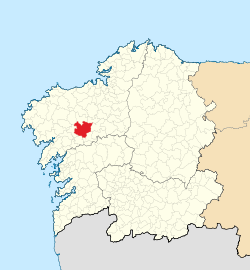 |
|||
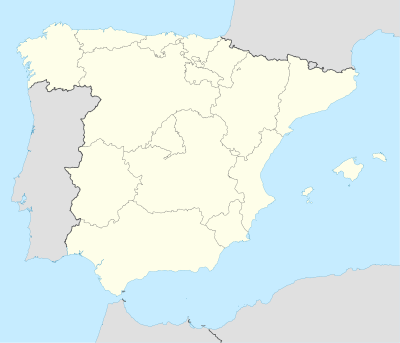 Santiago de Compostela
|
|||
| Coordinates: | |||
| Country | Spain | ||
| Region | Galicia | ||
| Province | A Coruña | ||
| County | Santiago | ||
| Parishes | Aríns, Bando, A Barciela, Busto, O Carballal, O Castiñeiriño, Cesar, Conxo, O Eixo, A Enfesta, Fecha, Figueiras, Fontiñas, Grixoa, Laraño, Marantes, Marrozos, Nemenzo, A Peregrina, Sabugueira, San Caetano, San Lázaro, San Paio, Santa Cristina de Fecha, Santiago de Compostela, Sar, Verdía, Vidán, Villestro, Vista Alegre | ||
| Government | |||
| - Type | Mayor-council | ||
| - Body | Concello de Santiago | ||
| - Mayor | Xosé Antonio Sánchez Bugallo (PSdeG) | ||
| - Councillors |
List
|
||
| Area | |||
| - Total | 220 km2 (84.9 sq mi) | ||
| Elevation | 260 m (853 ft) | ||
| Population (2009)INE | |||
| - Total | 95,092 | ||
| - Density | 428.81/km2 (1,110.6/sq mi) | ||
| Demonym | Santiagan santiagués (m), santiaguesa (f) compostelano (m), compostelana (f) pichelero (m), pichelera (f) |
||
| Time zone | CET (GMT +1) | ||
| - Summer (DST) | CEST (GMT +2) (UTC) | ||
| Area code(s) | +34 | ||
| Website | http://www.santiagodecompostela.org | ||
Santiago de Compostela (Spanish pronunciation: [sanˈtjaɣo ðe komposˈtela]) is the capital of the autonomous community of Galicia, Spain. The city's Cathedral is the destination today, as it has been throughout history, of the important 9th century medieval pilgrimage route, the Way of St. James (Galician: Camiño de Santiago, Spanish: Camino de Santiago). In 1985 the city's Old Town was designated a UNESCO World Heritage Site
Contents |
Toponym
Folk etymology for the name "Compostela" is that it comes from the Latin "Campus Stellae" (i.e. Field of Stars), but it is unlikely such a phonetic evolution takes account of normal evolution from Latin to Galician-Portuguese. A more probable etymology relates the word with Latin "compositum", and local Vulgar Latin "Composita Tella", meaning "burial ground" as a euphemism. Many other places through Galicia share this toponym (with identical sense) and there's a "Compostilla" in León province.
The city
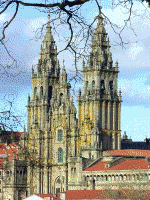
The cathedral borders the main plaza of the old and well-preserved city. Legend has it that the remains of the apostle James were brought to Galicia and in the early 9th century on a boat made of stone, and were later discovered at Santiago de Compostela. The cathedral was built in his honour on the spot where his remains were said to have been found. Across the square is the Pazo de Raxoi (Raxoi's Palace), the town hall and seat of the Galician Xunta, and on the right from the cathedral steps is the Hostal dos Reis Católicos, founded in 1492 by the Catholic Monarchs, Isabella of Castille and Ferdinand II of Aragon, as a pilgrim's hospice (now a parador). The Obradoiro façade of the cathedral, the best known, is depicted on the Spanish euro coins of 1 cent, 2 cents, and 5 cents (€0.01, €0.02, and €0.05).
Santiago is the site of the University of Santiago de Compostela, established in the early 16th century. The main campus can be seen best from an alcove in the large municipal park in the centre of the city.
Within the old town there are many narrow winding streets full of historic buildings. The new town all around it has less character though some of the older parts of the new town have some big apartments in them.
Santiago de Compostela has a substantial nightlife. Divided between the new town (la zona nueva or ensanche) and the old town (la zona vieja or a zona vella), a mix of middle-aged residents and younger students running throughout the city until the early hours of the morning can often be found. Radiating from the center of the city, the historic cathedral is surrounded by paved granite streets, tucked away in the old town, and separated from the newer part of the city by the largest of many parks throughout the city, Parque da Alameda. Whether in the old town or the new town, party-goers will often find themselves following their tapas by dancing the night away.
Santiago gives its name to one of the four military orders of Spain: Santiago, Calatrava, Alcantara and Montesa.
The prevailing wind from the Atlantic and the surrounding mountains combine to give Santiago some of Europe's highest rainfall: about 1,900 mm (75 inches) annually.
One of the most important economic centers in Galicia, Santiago is the seat for organizations like Association for Equal and Fair Trade Pangaea.
Demography
| Santiago de Compostela (Old Town)* | |
|---|---|
| UNESCO World Heritage Site | |
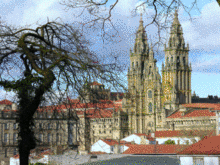 |
|
| State Party | |
| Type | Cultural |
| Criteria | i, ii, vi |
| Reference | 347 |
| Region** | Continental Europe |
| Inscription history | |
| Inscription | 1985 (9th Session) |
| * Name as inscribed on World Heritage List. ** Region as classified by UNESCO. |
|
| 1900 | 1930 | 1950 | 1981 | 2004 | 2006 |
|---|---|---|---|---|---|
| 24,120 | 38,270 | 55,553 | 82,404 | 92,298 | 93,458 |
| A Coruña Province Population c. 1787 | |||
|---|---|---|---|
| District | population | ||
| City of Coruña | 13,575 | ||
| City of Ferrol (Civilian Pop. Only) | 24,993 | ||
| Santiago de Compostela | 15,584 | ||
| Towns, Villages and Hamlets | c.229,123 | ||
| All the Province (Total): | 283,275 | ||
| (Ferrol - Urban History, 2004) [1] | |||
| A Coruña Province Population c. 1833 | |||
|---|---|---|---|
| District | population | ||
| City of Coruña | 23,000 | ||
| City of Ferrol (Civilian Pop. Only) | 13,000 | ||
| Santiago de Compostela | 28,000 | ||
| Towns, Villages and Hamlets | c.233,000 | ||
| All the Province (Total): | c.297,000 | ||
| (U. P. Gazetteer By Th.Baldwin, 1847) [2] | |||
| A Coruña Province Population c. 1900 | |||
|---|---|---|---|
| District | population | ||
| City of Coruña | 43,971 | ||
| City of Ferrol (Civilian Pop. Only) | 25,281 | ||
| Santiago de Compostela | 24,120 | ||
| Towns, Villages and Hamlets | 580,184 | ||
| All the Province (Total): | 653,556 | ||
| (Encyclopædia Britannica, 1911) s:User:Tim Starling/ScanSet PNG demo | |||
History
Santiago de Compostela was originally founded by the Suebi in the early 400s, as part of the collapse of the Roman Empire. Then, in 584 the whole settlement together with the rest of Galicia and northern Portugal was incorporated by Leovigild into the Visigothic kingdom of Spain. Raided from 711 to 739 by the Arabs, Santiago de Compostela was finally recaptured by the Visigothic king of Asturias in 754, about 60 years before the identification of remains as those of Saint James the Great, and their acceptance as such by the Pope and Charlemagne, during the reign of Alfonso II of Asturias. From then on, this settlement was not just a city, but a holy city, and one of the main centers of Christian pilgrimage, rivaled only by Rome itself and the Holy Land. Still, there are some who claim that the remains found here were not those of the apostle James but those of Priscillian. They are also thought by many to be someone else altogether. Christian persecution of Spain's Muslims, following the fall of the Moorish state in 1492, echoes into present time, with local residents evincing antipathy towards those who are visibly Muslim.
Santiago de Compostela was captured by the French during the Napoleonic War and its capture broke the spirits of the many Spanish guerillas who were fighting the mighty invading armies of Marshals Soult, Victor, Massena and Napoleon's brother, the new King of Spain, Joseph Bonaparte. During the war, many attempts were made to recapture it by Spanish partisans, who believed St James would come down on the field and destroy the French if they earned his favour by beating the French out of the holy city, which was St James's city. Many of the attempts to return the holy city to the Spanish failed, and the only one that didn't fail was unsuccessful in retaining its hold on the city, and the combined British and Spanish forces were beaten back, where they retreated with the British, and the city was back in French hands within 48 hours.
Way of St. James
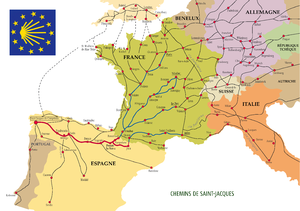
The legend that St James found his way to the Iberian peninsula, and had preached there is one of a number of early traditions concerning the missionary activities and final resting places of the apostles of Jesus. Although the 1884 Bull of Pope Leo XIII Omnipotens Deus accepted the authenticity of the relics at Compostela, the Vatican remains uncommitted as to whether the relics are those of Saint James the Great, while continuing to promote the more general benefits of pilgrimage to the site. According to a tradition that can be traced before the 12th century, the relics were said to have been discovered in 814 by Theodomir, bishop of Iria Flavia in the west of Galicia. Theodomir was guided to the spot by a star, the legend affirmed, drawing upon a familiar myth-element, hence "Compostela" was given an etymology as a corruption of Campus Stellae, "Field of Stars."
The establishment of the shrine

As suggested already, it is probably impossible to know whose bones were actually found, and precisely when and how. Perhaps it does not matter. What the history of the pilgrimage requires, but what the meagre sources fail to reveal, is how the local Galician cult associated with the saint was transformed into an international cult drawing pilgrims from distant parts of the world.
The 1000 year old pilgrimage to the shrine of St. James in the Cathedral of Santiago de Compostela is known in English as the Way of St. James and in Spanish as the Camino de Santiago. Over 100,000 pilgrims travel to the city each year from points all over Europe and other parts of the world. The pilgrimage has been the subject of many books and television programmes, notably Brian Sewell's The Naked Pilgrim produced for UK's Five.
Pre-Christian legends
As the lowest-lying land on that stretch of coast, the city's site took on added significance. Legends supposed of Celtic origin made it the place where the souls of the dead gathered to follow the Sun across the sea. Those unworthy of going to the Land of the Dead haunted Galicia as the Santa Compaña.
Main sights
- 16th century Baroque Abbey de San Martín Pinario
- Cathedral of Santiago de Compostela
- University of Santiago de Compostela
Transportation
Santiago de Compostela is served by Santiago de Compostela Airport[1] and rail service. There are also plans to provide access to Santiago de Compostela by the Spanish High Speed Railway Network, a project under construction.
Sister cities
Santiago de Compostela is twinned with:
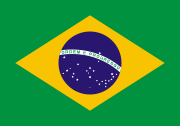 São Paulo, Brazil[2][3]
São Paulo, Brazil[2][3]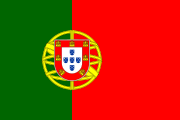 Santiago do Cacém, Portugal, since 1980s
Santiago do Cacém, Portugal, since 1980s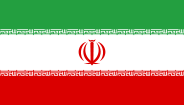 Mashhad, Iran
Mashhad, Iran Buenos Aires, Argentina, since 1980s
Buenos Aires, Argentina, since 1980s Qom, Iran
Qom, Iran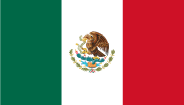 Santiago de Querétaro, México (2005)
Santiago de Querétaro, México (2005) Santiago de los Caballeros, Dominican Republic (2004)
Santiago de los Caballeros, Dominican Republic (2004)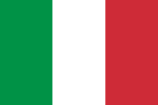 Assisi, Italy (2008)
Assisi, Italy (2008) Pisa, Italy (2010)
Pisa, Italy (2010)
See also
- Order of Santiago
- Música en Compostela
References
 This article incorporates text from a publication now in the public domain: Chisholm, Hugh, ed (1911). Encyclopædia Britannica (Eleventh ed.). Cambridge University Press.
This article incorporates text from a publication now in the public domain: Chisholm, Hugh, ed (1911). Encyclopædia Britannica (Eleventh ed.). Cambridge University Press.
- Notes
- ↑ The airport code for Santiago de Compostela’s Metropolitan Airport is (IATA: SCQ, ICAO: LEST).
- ↑ Prefeitura.Sp - Descentralized Cooperation
- ↑ International Relations - São Paulo City Hall - Official Sister Cities
External links
- Photo panoramic 360 of Santiago - Visita Virtual
- Map of Santiago
- Santiago de Compostela: Journey's End by The Guardian
- Santiago's Football Team
- Santiago's Basketball Team
- Concello de Santiago de Compostela
- Pilgrim community on the Camino de Santiago
- Walking the Camino de Santiago, A Guide
- Photographs of Santiago de Compostela Cathedral and Monasteries of Galicia
- Webcam of Santiago cathedral square, where the pilgrims arrive at all times of the day.
- Photos of Santiago de Compostella
- Video of Santiago de Compostela on YouTube
- Santiago Tourism
- Information on Santiago out of Santiago
|
|||||||
|
|||||||
|
|||||||||||||||||||||||||||||||||
|
|||||
